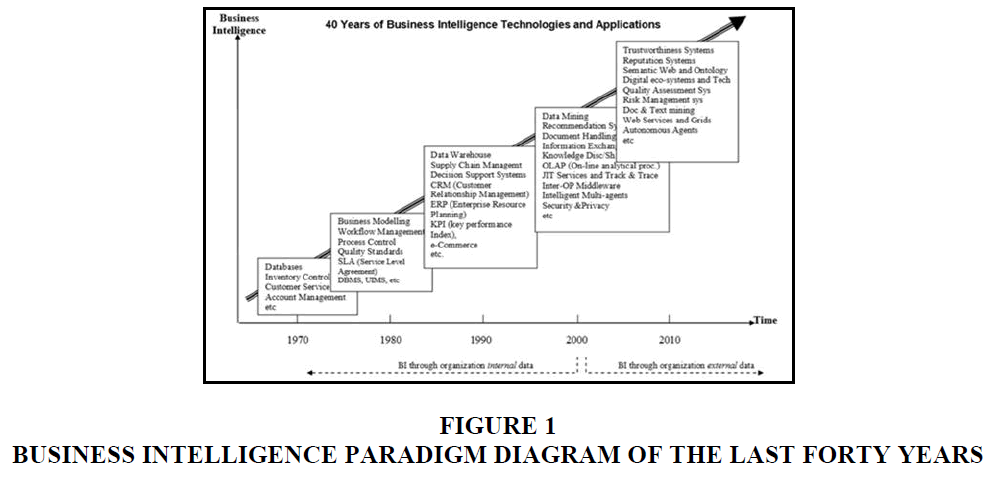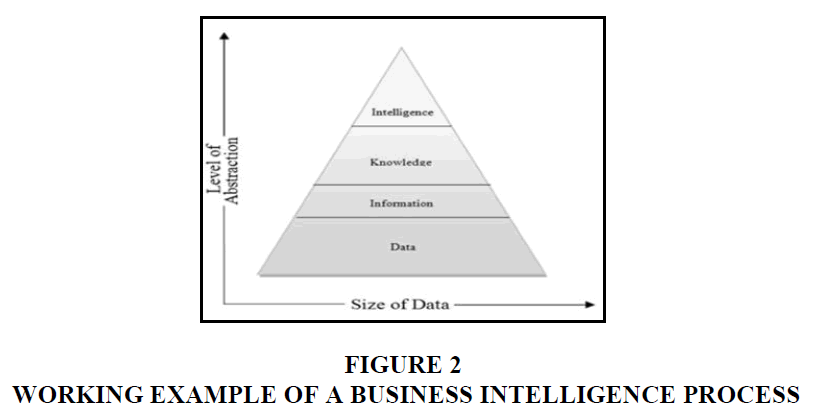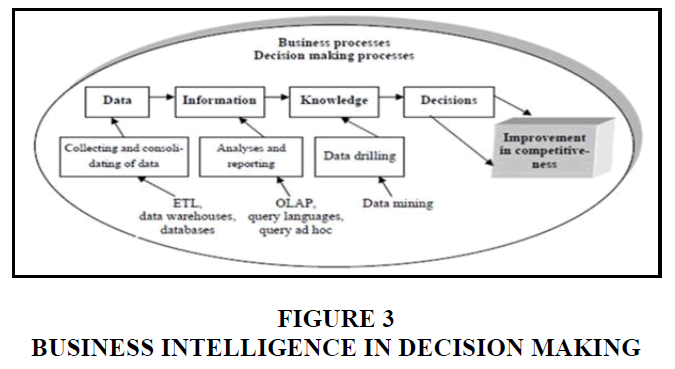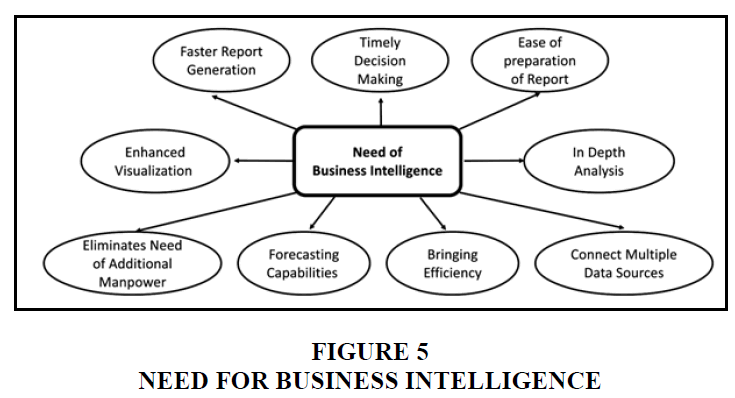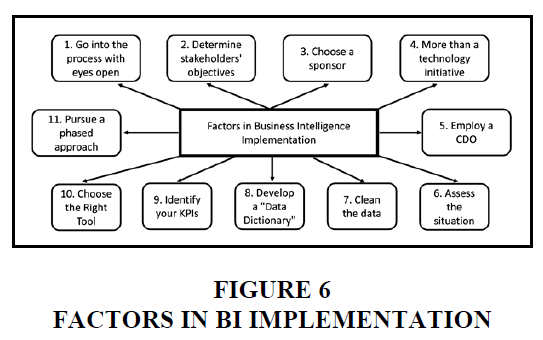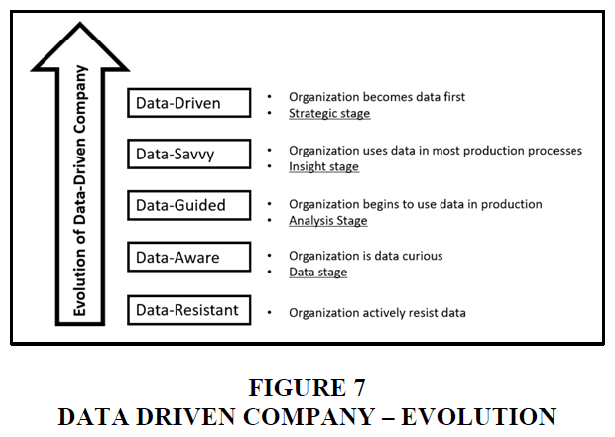Review Article: 2023 Vol: 27 Issue: 2S
Business Intelligence - The Propeller of eCommerce Business
Ashish Kumar Biswas, Narsee Monjee Institute of Management Studies Deemed to be University
Hariharan K, ILS, The ICFAI Foundation for Higher Education Deemed to be University
Citation Information: Kumar Biswas, A., & Hariharan, K. (2023). Business intelligence – the propeller of ecommerce business. Academy of Marketing Studies Journal, 27(S2), 1-10.
Abstract
Business Intelligence (BI), the game changer in driving organisations into the future calls for great commitment from the senior management. A multi-pronged approach with leadership to penetrate into all levels of the organization to bring in a change in culture, maturity of acceptance, integrate new business and handhold throughout the process to gain competitive advantage and smarter results. In a data rich business environment, the key lies in computing, applications, storage and managing data. Individuals, companies and domain experts rage for the best of the solutions. IT solution providers including Microsoft, Oracle and IBM have rolled out their suites in the form of cloud computing, block chain and resources allocation platforms. This study is aiming at analyzing the concepts and theories related to business intelligence and market analysis. This study will first review the available literature on the concepts and then form the problem statement, which will further be researched by the researcher to determine the study's outcome.
Keywords
Innovation, Business Intelligence, Market Analysis, E-Commerce, Data Mining
Introduction
Overseeing business exercises has never been simple. Likewise, financial states make it harder. The test is to act more or less and to settle on choices superior to contenders. Having prompt access to present and important data can have a significant effect. It is the motivation behind the dynamic growth of Business Intelligence during severe monetary downturns Tripathi et al. (2020).
The evolution of eCommerce as a business medium has given BI's propulsion and has been on a continuous transformation.
Research analysts of Retail Economics last year found that 53% of retail sales expected to be online by 2028.Globally, Artificial Intelligence, SaaS, Financial Tech and Ecommerce are the sectors creating competent unicorns, as high as 46 percent in the unicorn space. In India, Ecommerce rules the show with 33% of unicorns.
Business Intelligence, frequently alluded to as 'BI,' a widely used term, coined by Turban et al. (2010) in the mid-1990s. Be that as it may, the idea is a lot more seasoned; in early 1959, IBM scientist Hans Peter Luhn utilized the term Business Intelligence. He characterized 'intelligence' as: "the capacity to catch the interrelationships of introduced realities to control activity towards an ideal objective."
Evolution
Business Intelligence has its underlying foundations in the administration data frameworks (MIS), revealing frameworks of the 1970s. During that period, announcing frameworks were static, two-dimensional, and had no systematic capacities. Those days, a great Business Intelligence-based organization's data framework incorporates the whole data administrators need. So the first idea of EIS was changed into Business Intelligence. By 2005, Business Intelligence frameworks have started to include human-made brainpower capacities other than ground-breaking investigative a Business Intelligence.
It took 40 years for Business Intelligence to be created, as shown in the Figure below. In the first century, the attention was on interior association information. Business Intelligence frameworks and innovations concentrated, for the most part, on key and strategy levels. In the most recent decade, a center move has been made through including outer information to fit the nature of Business Intelligence frameworks by operational clients and frameworks Figure 1.
Assessment of the idea of BI, together with the related innovation and apparatuses, is shown in the Figure above. As of now, BI is generally centered on the thoughts of data mining, recommender frameworks, and Knowledge Discovery Techniques. These speak to exceptionally noteworthy highlights of Business Intelligence. In any case, they are limited by the trademark that they lead this quest for information inside hierarchical databases that either speaks to helpful;
1. Information that the association endeavors itself has gathered about exercises and exchanges with different associations and buyers.
2. Information comparable to different units, viewpoints, and people inside the associations.
With the change of the modern culture to the information society, it was basic somewhat unavoidable to choose, organize, and build data in the firm. Innovation has caused such a lot of distinction that its contribution through human asset capital has prompted the natural relationship's rise as a more extraordinary potential. The evolvement of information advances as of now speaks to the asphalt for the associations a Business Intelligence process to redesign information frameworks that fulfill the new needs of the board. Information society and information the executives play a relevant and coordinating job in current business situations. Porta Business Intelligence, network, development, and ongoing response are a portion of today's jargon's primary catchphrases.
The feasible upper hand is noteworthy in its capacity to course the most basic information to build up the Business Intelligence that empowers it to ceaselessly reevaluate its techniques and objectives to fulfill its necessities progressively. Business Intelligence is a moderately new term. The old-style systems for Business Intelligence assessment in its IT zone are not compelling enough to perform. Embracing Business Intelligence is typically administered by programming suppliers and experts.
This is utilized to classify a comprehensive gathering of programming bundles, procedures, and applications to aid dynamic towards better, proficient, and meaningful choices. It is proposed that Business Intelligence speaks to a foundation to help a broad grouping of business applications like data examination, data mining, data questioning other than the executives revealing. Various preferences can be seen in different regions in the applicable firms, such as the budget summary region. Subsequently, it is so tricky to attribute the framework business esteem legitimately. The fundamental objective of Business Intelligence is to help the dynamic procedure. The Figure underneath shows a progressive perspective on a Business Intelligence procedure Figure 2.
A Business Intelligence framework can be characterized as a procedure of transforming data first into information and. There are various definitions introduced by authors, scientists, and researchers about the expression "Business Intelligence." Every definition is identified with the logical foundation of the person's understanding or point of view. Thus, a Business Intelligence definition is being presented in the accompanying.
Review of Literature
Chang et al., 2006 have characterized Business Intelligence as another business-driven wonder that can add esteems to associations. He further said that Business Intelligence is an umbrella term for an assortment of strategies, advancements, and applications. Minelli et al. (2013) accepted that Business Intelligence is a lot of instruments and techniques intended to misuse important information from its information resources. At the same time, Popovič et al. (2012) depicted Business Intelligence as a way to deal with the board that permits an association to characterize what information is helpful and significant to its corporate dynamic. Hiltbrand & Burke (2011) portrayed Business Intelligence as a procedure of assortment, treatment, and dissemination of information that has a goal containing the decrease of vulnerability in settling on every vital choice.In the recent research, Alexander. M (2017) focuses on the importance of BI in the process of any organizational evolution by adding flexibility in the existing business process.
Immense information is available with organization at lower or free of cost, but data being double edged sword it can guide or mislead the future direction as it not possible for human to gather, analyze, and utilize the information effectively (Khurana 2017).
Elbashir et al. (2011) characterized Business Intelligence as the way toward taking many data, examining that data, reports and essential choices for decision making.Customer behaviour and factors influencing customer behaviour is taking technical shift in ecommerce for some products and brands so mastery over it with the help of BI will be a competitive edge over other companies Khrais (2020).
Khan & Quadri (2012), just as Shollo & Kautz (2010) both depicted Business Intelligence as an applied arrangement of measures and intends to advance business through better creation of choices by using electronic emotionally supportive networks based. Foley & Guillemette (2010) alluded that Business Intelligence essentially has two different key implications applicable to utilizing the term 'intelligence.'Report says 85% of invaluable intelligence initiatives do not offer optimum result as they lack in understanding and implementation of technology, people, and processes together Zhang et al. (2021). Whereas Soni (2020) emphasis on the scientific implementation as it will not only address the risk involved but will help people to excel in their BI goals such as sales and customer relationship in ecommerce business.
The primary importance, which is only from time to time, is the limit of human resources applied in business exercises. Business Intelligence is another field of researching the use of human psychological scholarly limits and human-made reasoning advancements to suit the administration and choice taking in various business challenges. The subsequent significance is to relate the intelligence with the information-esteemed measurement for its pertinence and money. It envelops information and innovations other than master information, instructing, and successfully dealing with the individual and authoritative business. Business Intelligence is a broad class of advancements and applications to accumulate, give, reach, and investigate data expecting to help the organization's clients settle on progressively clear business choices.
Shmueli et al. (2011) showed that the term Business Intelligence signifies to have a mind-boggling acknowledgment of all critical factors that influence the business. He figured that it is unavoidable for the companies to increase profound information identified with factors like the contenders, clients, financial condition, business accomplices, and inner exercises to keep up reasonable business choices. He presumed that Business Intelligence empowers firms to settle on these sorts of choices. Sauter (2014) proclaimed that Business Intelligence consolidates operational data with investigative devices to introduce detailed and critical information to organizers and chiefs to improve the dynamic procedure's practicality. He further said that Business Intelligence is a lot of instruments, innovations, and modified items utilized to gather, incorporate, and make data as a business tool. Duan & Da Xu (2012) broke down the originations of Business Intelligence and presumed that data capturing is reasonably fair.Ujang et al., 2020 has characterized various factors that impact the business intelligence achievement used in the decision making. The major factors are user access, cross functional integration, quality of data, leadership commitment on strategic level, analytical decision-making ability, flexibility, and user satisfaction Chaudhuri et al. (2011). Holistic approach to transform any business process is the key to success. Organization can anchorage business intelligence totransform themselves in case of absence it might lead to many alignment and integrational concern (Ramakrishnan T., 2020).
Also, they found that although Business Intelligence is portrayed as a data-driven procedure for better alternatives, it regularly stays muddled how Business Intelligence is utilized in decision making.BI solutions are evolving day by day with better tools, cross functional data, and availability of resources. Hence author defines and explains the areas which need further exploration (Anuj T, 2020).
Discussion
Business Intelligence today is the growth engine of any business. As the market has turned into customer-driven for which data is the key, corporates are stretching themselves to ensure that data capture is done at every transaction point. With the ERPs and Salesforce in use, data rules the functions – from procurement to production planning and logistics to marketing campaigns. No wonder data is the new Oil – the new corporate & economic adjective. This paper reviews the significance, role, need, and critical factors of BI.
Significance of Business Intelligence
As Loshin (2012) indicated, the Business Intelligence job is to get out the information figured vital to the business and offered or control information from data that are imperative in supporting administrative choice through the applying of Business Intelligence. Though Chau & Xu (2012) saw that to empower any firm in executing the appropriate methods logically focusing on data to change into information, it is a noteworthy need to see how to apply Business Intelligence Chen et al. (2012). Hence, this will prompt a higher significance objective, including changing data into decision-making points, which will improve the choices-making process as exhibited in the Figure beneath Figure 3.
In the Business Intelligence procedure, preparing attributes of Business Intelligence includes two primary stages. The first stage is data acquisition, collecting data from different wellsprings of different characteristics into reliable information. The subsequent stage is information examination to make information into knowledgeable action points, as shown in the Figure underneath Figure 4 Williams & Williams (2010).
The Need of Business Intelligence
The significance of Business Intelligence is not constrained to retailers. Media communications bearers use Business Intelligence to recognize and moderate programs. Shared mobility services and E-commerce businesses use BI as their lifeline, as it is a planning and service mapping tool for better customer service.
Corporates are turning out to be data-rich and information poor. Business intelligence is the present tech need for an explanation: Information is developing at an exponential rate. Data in undertakings is required to arrive at 120,000 petabytes by 2021 as indicated by another overview by International Data Corporation.
As data develops, corporates' requirement to oversee it and make it a noteworthy decision point develops too. Conveniently getting that data, pass it through a logical process for the evolution of decision ideas, which would lead to implementation.
Timely business intelligence has become a mission fundamental to numerous endeavors. E-commerce companies prioritize their functions to make sure the server downtime is almost zero. The loss of transaction time could be a challenge to customer satisfaction and lead to adverse outcomes, including the revenues Subagja et al. (2020).
To deal with the torrential slides of data, business intelligence instruments are getting progressively far-reaching. E-commerce companies provide access to select data to internal customers as well as service providers, logistics partners, and merchants Figure 5.
Right data tells management what kinds of changes will move things in the organization toward an increasingly beneficial final result and gives better expertise and competitive advantage Yeoh & Koronios (2010).
BI tools are primary to eCommerce businesses, as the platforms are data-driven and require greater accuracy and decision support information.
Visitors who surf the eCommerce portal or app, tend to add products to their cart but not complete the checkout or buy the product. It is termed as an abandoned cart, and companies consider this as a potential billing avenue, as the visitor can be pulled back into the buying process. As of 2018, cart abandonment rate across the globe was at an average of 75%, translating to three fourth of surfers who moved the product to the cart, do not make the purchase. Abandoned cart email is a sales strategy used by eCommerce companies to make the customer relook at the cart, and surprisingly this leads to 12% recovery rate. Data analytics companies state that in all likelihood, customers come back to buy the entire abandoned cart. Effectively, the follow-up triggers additional revenue.
Retargeting is a strategy used to re-engage visitors who had left without making a purchase. A cookie is enabled on their computers to show likeable ads on other sites they visit through paid options.
The idea of retargeting is to create brand exposure to those visitors who had left unproductive. Frequent advertisements are natural and psychological ways to lure the visitor back into the product buying decision process. This has its own positive effects and success rates. Google ‘Remarketing’ is a game changer in this space and an extended version of re-engagement.
Retargeting through advertisements is a strategy for targeting at an early stage and mail re-marketing is widely used to target those who show intent to buy.
The exponential growth of eCommerce is visible over the years. Companies focus on this vertical by investments, acquisitions, more comprehensive product portfolios and so on. Reliance Industries Limited (RIL), set to reengineer the eCommerce space, has been investing big in the market and technology. Jio platform, part of RIL, has partnered with Facebook (9.9% share) and Google (7.73%) through stake stale. Both of them are global data-driven companies, and Jio plans to use Whatsapp as a business and supply chain tool. RIL, over the last three years, has acquired Saavn (Music Streaming app), Embibe (Ed-tech startup), Fynd(020 commerce platform) Haptik (Chatbot) Reverie (local language services) NowFloats(small biz platform). All these acquisitions point to the future of retail business – Data, BI, and AI.
RIL is at the final stages of buying furniture brand "Urban Ladder", milk delivery platform "Milkbasket" and many more. The company aims to compete with Amazon and Walmart-owned Flipkart in the e-commerce segment. To add to the basket, RIL is in talks to buy e- pharmacy Netmeds.
It may be noted that online grocery orders, including daily essentials like milk, bread, and eggs, have increased since the pandemic outbreak.
BI helps the companies on the following key factors:
1. Performance Analysis: Products, channels, customer segments, promotional campaigns.
2. Trend Analysis: Customer preferences and behavior.
3. Margin Analysis: Product lines, price band, demand measures, cost and margins.
4. Marketing Reports: Search engine optimizations, move to cart, response for campaigns, cart abandonment.
5. Sales Report: Coupons, supply chain, returns, refunds, sales,taxes, offers, payment preferences.
6. Inventory Reports: Orders on hand, inventory, goods sold, reorder, new items, transit.
Critical Success Factors in Business Intelligence Implementation
A Business Intelligence venture is indistinguishable from the mission of the corporate. Top Management support is crucial for BI and should spread across all the functions as part of their daily routines. Additionally, an investigation by Watson et al. demonstrates that excellent Business Intelligence support should originate from a business work. Such support regularly has a substantial stake in the accomplishment of the Business Intelligence activity.
In a study, Boston Consulting Group (BCG) states that Executives spend considerable time to the extent of 40%, in reports and coordinating with different stakeholders to analyze the reports. According to the Harvard Business Review, close to 98 percent of data collected, goes unutilized or not taken for further analysis.This is why BI acts as a game changer in automating the process.
A Business Intelligence framework execution is a versatile data improvement activity for choosing the best course of action. It has been further demonstrated that the regular application-based subsidizing model for usage of value-based frameworks does not make a difference to Business Intelligence frameworks that are developmental. That is, a Business Intelligence framework advances through an interactive procedure of improvement as per dynamic business necessities.
A BI activity is a business-driven venture and is necessary for the creation of crucial choices. From a technical aspect, a Business Intelligence venture is practically identical to a frameworks reconciliation venture and requires the dynamic inclusion of the undertaking's business side Figure 6.
Accenture study has found that 80% of professionals accept that embracing big data will keep the organization alive and move forward.
Commonly, the venture group needs to manage various stages, numerous interfaces, association with inheritance frameworks, various apparatuses, etc. Every one of these errands calls for individuals with various abilities and skills; thus, an appropriate blend of specialized and business mastery is a key to progress. The information distribution center's structure and model must be firmly identified with their impression of the business goals and procedures to empower business clients to explore and control the information model.
Adapting to advanced BI keeps the business relevant with data being used for smart decisions. The benefits of this will be visible at every output points, viz., process, market intelligence, procurement, P&L and so on.
A business analytics service, Power BI from Microsoft, helps executives make effective decisions. Data are converted into reports to help organisations through a dashboard enabling a quick and efficient review of the status.
Power BI offers:
1. Cloud Service
2. Mobile Access
3. Integrations: API requests, SQL Servers, and RSS feeds will be integrated with the BI
4. Data from Google Analytics, cloud based CRM service Salesforce, marketing automation platform
5. Mailchimp, Linkedin Navigator can be integrated for data points.
6. Power Platform
7. AI Capabilities can offer Sentiment Analysis, Extract Key Phrase, detection of language and tagging of image.
Future Direction
BI software is fast developing as it becomes an essential tool for eCommerce companies. BI's future sees an increase in features that enable ease of use, streamlined workflows, and predictive abilities. The future of BI will to a great extend depend on the key factors like collaboration, integration, machine learning, network advancements and most importantly, data driven approach by corporates.
The authors stress the importance of data driven approach as it not just provides a framework but develops a culture to adopt and improvise. Adopting a data-driven culture involves giving all employees the resources to incorporate BI into everyday processes. The data driven approach begins with the top management and needs to be adopted across the levels to make sure the company evolves into a data focused business function. Success of this process depends on adoption of the concept at unit or functional level which can really add value to the overall efforts. Continuous pursuance leads to data driven professionals.Organisationswill go through various stages as presented in the figure below Figure 7.
Future researchers have potential avenues in the above-mentioned areas as it is vast, and the findings would contribute to various stakeholders in academicians, industry reference, and research laboratories.
Conclusion
Business Intelligence gives firms to create better-educated choices and hence can be the premise of upper hands. It will be incredibly right at whatever point associations can gauge the most meaningful information from markers in the external business condition and make exact conjectures identified with upcoming designs and the financial states.
The last intention of Business Intelligence is to raise and improve the practicality and nature of the information. Significant information like having a gem ball that can show the best activity to pick is a BI job. Infact, business intelligence unveils competitive intelligence, social, administrative, and current world of politics, market conditions viz., financial information, segment, future patterns, competence of the E-commerce platform, changes expected in shoppers, needs, conduct, and spending models.
Businesses strive to stay ahead of the loop to transcend the dynamic market environment and be a robust adapter to new challenges. The Life Cycle is fast shrinking, and companies need to keep inventing strategies to survive and succeed.
References
Tripathi, A., Bagga, T., & Aggarwal, R. K. (2020). Strategic impact of business intelligence: A review of literature. Prabandhan: Indian Journal of Management, 13(3), 35-48.
Chau, M., & Xu, J. (2012). Business intelligence in blogs: Understanding consumer interactions and communities. MIS quarterly, 1189-1216.
Indexed at, Google Scholar, Cross Ref
Chaudhuri, S., Dayal, U., & Narasayya, V. (2011). An overview of business intelligence technology. Communications of the ACM, 54(8), 88-98.
Indexed at, Google Scholar, Cross Ref
Chen, H., Chiang, R. H., & Storey, V. C. (2012). Business intelligence and analytics: From big data to big impact. MIS quarterly, 1165-1188.
Indexed at, Google Scholar, Cross Ref
Zhang, D., Pee, L. G., & Cui, L. (2021). Artificial intelligence in E-commerce fulfillment: A case study of resource orchestration at Alibaba’s Smart Warehouse. International Journal of Information Management, 57, 102304.
Indexed at, Google Scholar, Cross Ref
Duan, L., & Da Xu, L. (2012). Business intelligence for enterprise systems: A survey. IEEE Transactions on Industrial Informatics, 8(3), 679-687.
Indexed at, Google Scholar, Cross Ref
Elbashir, M. Z., Collier, P. A., & Sutton, S. G. (2011). The role of organizational absorptive capacity in strategic use of business intelligence to support integrated management control systems. The Accounting Review, 86(1), 155-184.
Indexed at, Google Scholar, Cross Ref
Foley, É., & Guillemette, M. G. (2010). What is business intelligence?. International Journal of Business Intelligence Research (IJBIR), 1(4), 1-28.
Hiltbrand, T., & Burke, M. (2011). How gamification will change business intelligence. Business Intelligence Journal, 16(INL/JOU-11-21248).
Khan, R. A., & Quadri, S. M. K. (2012). Business intelligence: an integrated approach. Business Intelligence Journal, 5(1), 64-70.
Khrais, L. T. (2020). Role of artificial intelligence in shaping consumer demand in E-commerce. Future Internet, 12(12), 226.
Indexed at, Google Scholar, Cross Ref
Loshin, D. (2012). Business intelligence: the savvy manager's guide. Newnes.
Sauter, V. L. (2014). Decision support systems for business intelligence. John Wiley & Sons.
Shmueli, G., Patel, N. R., & Bruce, P. C. (2011). Data mining for business intelligence: Concepts, techniques, and applications in Microsoft Office Excel with XLMiner. John Wiley and Sons.
Shollo, A., & Kautz, K. (2010). Towards an understanding of business intelligence.
Soni, V. D. (2020). Emerging roles of artificial intelligence in ecommerce. International Journal of trend in scientific research and development, 4(5), 223-225.
Turban, E., Sharda, R., & Delen, D. (2010). Decision support and business intelligence systems (required). Google Scholar.
Subagja, U., Hermanto, A. S., & Wang, G. (2020). Measuring Success Factors for Business Intelligence: Management Perspective. International Journal of Science and Applied Information Technology, 9.
Williams, S., & Williams, N. (2010). The profit impact of business intelligence. Elsevier.
Yeoh, W., & Koronios, A. (2010). Critical success factors for business intelligence systems. Journal of computer information systems, 50(3), 23-32.
Received: 29-Oct-2022, Manuscript No. AMSJ-22-12765; Editor assigned: 30-Oct-2022, PreQC No. AMSJ-22-12765(PQ); Reviewed: 14-Nov-2022, QC No. AMSJ-22-12765; Revised: 28-Nov-2022, Manuscript No. AMSJ-22-12765(R); Published: 07-Dec-2022
